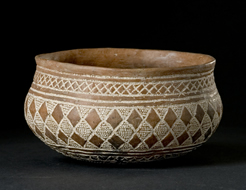|
||||||||||||||||||||||||||||||||
|
|
Museum of: Rome | |||||||||||||||||||||||||||||||
| Name of the artefact: Bell Beaker Ware cup | ||||||||||||||||||||||||||||||||
|
From the large shaft of Fosso Conicchio grave comes a
lot and variety of the famous Iron Age ‘bell-beakers’. The strategic
role of this item as the first pan-European prestige gift in the
changing networks between big-man is now fully recognized, with a
special regard at the decorative code of the stripes recovering the
whole surface of the vessel. |
||||||||||||||||||||||||||||||||
|
WHERE IS IT AND MAIN CHARACTERISTICS |
STATE |
|||||||||||||||||||||||||||||||
|
Department: |
- |
Preservation: |
Very good | |||||||||||||||||||||||||||||
|
Inventory number: |
109327 |
Restauration: |
No restored | |||||||||||||||||||||||||||||
|
Name of the artefact: |
Bell Beaker Ware cup |
Completeness: |
Complete | |||||||||||||||||||||||||||||
|
Object type: |
Vessel/Anphora |
|||||||||||||||||||||||||||||||
|
Material: |
Pottery |
|||||||||||||||||||||||||||||||
|
Methof of manufacture: |
- |
|||||||||||||||||||||||||||||||
|
Decoration type: |
No decoration |
|||||||||||||||||||||||||||||||
|
Distinctive mark: |
- |
|||||||||||||||||||||||||||||||
|
DIMENSIONS |
PERIOD OF USE |
|||||||||||||||||||||||||||||||
|
Length (mm): |
- |
Epoque: |
Eneolithic |
|||||||||||||||||||||||||||||
|
Heigth
(mm): |
98 |
Culture: |
Rinaldone |
|||||||||||||||||||||||||||||
|
Diameter
(mm): |
67 |
Period: |
Late Eneolithic Period< |
|||||||||||||||||||||||||||||
|
Width (mm): |
- |
Face: |
- |
|||||||||||||||||||||||||||||
|
Thickness (mm): |
- |
Absolute chronology: |
2500-2200 BC |
|||||||||||||||||||||||||||||
|
Weight
(g): |
- |
|||||||||||||||||||||||||||||||
DISCOVERY |
||||||||||||||||||||||||||||||||
|
Date: |
1968 |
Country: |
Italy |
|||||||||||||||||||||||||||||
|
District: |
Lazio |
Town hall affiliation: |
Viterbo |
|||||||||||||||||||||||||||||
|
Village: |
- |
Discovery findspot: |
Fosso Conicchio |
|||||||||||||||||||||||||||||
|
Condition of discovery: |
Chance Discovery |
Discovery type: |
Deposit |
|||||||||||||||||||||||||||||
|
ANALYSES – DETERMINATIONS |
FILLED IN BY |
|||||||||||||||||||||||||||||||
|
Type: |
- |
Name: |
Chiara Delpino, Vincenzo Tinč |
|||||||||||||||||||||||||||||
|
Laboratory: |
- |
Institution: |
- |
|||||||||||||||||||||||||||||
|
No./Code: |
- |
Date: |
10-2005 |
|||||||||||||||||||||||||||||
|
DEEPENINGS |
||||||||||||||||||||||||||||||||
|
Morphology of the object: |
||||||||||||||||||||||||||||||||
|
Short Bell Beaker style decorated cup, with a flared
rim, globular shaped body and rounded base. The surface of the pottery,
carefully polished, is of a reddish color with rare gray spots. The
ceramics is of a fine craftsmanship with a partially depurated paste. |
||||||||||||||||||||||||||||||||
|
Decoration: |
||||||||||||||||||||||||||||||||
|
The body of the cup is entirely decorated with a thick
“comb” impressed decoration, characteristic of Bell Beaker Ware. The rim
is decorated with a series of triangles, with their vertex pointing
upwards, below which there is a plain band. Follows a wide band
decorated with oblique opposing lines, another plain band with zig-zag
patterns with the spaces filled in by “comb” impressions. Below these
there are two wide bands decorated with oblique opposite lines. In the
lower part there is an alternation of oblique impressed bands and plain
ones. |
||||||||||||||||||||||||||||||||
|
Inscription: |
||||||||||||||||||||||||||||||||
|
- |
||||||||||||||||||||||||||||||||
|
Analogies: |
||||||||||||||||||||||||||||||||
|
Most of the Bell Beaker ware found at Fosso Conicchio
can be categorized as “Italian Style” because of their horizontal
decorations with an alternation of plain bands and decorative ones. The
decorative motifs seem similar to the ones recovered at Grotte del
Fantino, in Tuscany, and at the sites of Sant’Ilario and Rubiera, in
Emilia Romagna. In regard to the context of the site in its integrity,
artificial hypogeums datable back to the Eneolithic Periods not
associated to funerary usage are nearly unknown in Central Italy. In
regard to the Rinaldone facies only one example of small artificial
grotto at Corano (Pitigliano, Grosseto) has been identified. The
structure lacked skeleton remains but was characterized by some building
peculiarities that suggest cult usage. Cult practice and Bell Beker
objects are also attested in the Grotte del Fontino (Grosseto) in which
more than 100 funerary depositions were found as well as hearts and
several animal bone fragments. On the Adriatic side of the peninsula,
inside the Grotta della Tanaccia, at Brisighella, were recovered
skull-caps lacking traces of fire linked to Bell Beaker ware. |
||||||||||||||||||||||||||||||||
|
Interpretation: |
||||||||||||||||||||||||||||||||
|
The cup was recovered in an hypogeum carved within
sandstone lacking a volt and completely filled with soil. Within the
structure a total of around 90 vessels, some of which whole while others
in fragments, were recovered. Ten of these are decorated with impressed
techniques that can be traced back to the Bell Beaker style. 40 lithic
tools were also recovered among the pottery, four of which “brassards”.
The hypogeum consists of an ovoidal shaped room 3,10 by 2,90 m with a
maximum height of 1,75m. Within the room, in the middle of the Eastern
wall is present a trapezoidal shaped bench, with its rim delimited by a
short rail. There are no traces of side corridors departing the room as
well as no stone ceiling: it is therefore possible to suggests an
entrance from the top probably covered by a wooden mobile covering. Of a
large number of vessels recovered during the fortuitous discovery of the
hypogeum, while workers were laying down a pipeline, there is no
information regarding the original position of the ware, while the
location of around 50 objects is attested: these were mainly located on
the bank or around it. On the semi-burned fragments of skulls and long
bones were also found as well as lithic tools and fire remains. Because
of the building technique of the structure at Fosso Conicchio (which has
been associated to the contemporary Eneolithic Period oven tombs of the
Rinaldone facies) a predominantly funerary use was suggested. Recently
on the base of the structure’s typology there has been a
reinterpretation of the data. The presence of a bank, the absence of
horizontal entrances and the large dimensions of the hypogeum at Fosso
Conicchio- are however characteristics absent in contemporary Rinaldone
tombs. It has been therefore suggested that the structure had been used
for cult rituals. Along with this theory the bank could have been an
altar; theory in line with the analysis of the objects found on the bank:
small ware (suited to store liquids and food) fragments of skulls and
long bones, lithic tools and traces of fire. |
||||||||||||||||||||||||||||||||
|
Bibliography: |
||||||||||||||||||||||||||||||||
|
BARFIELD L.H., 1987, The italian Dimension of the
Beaker Problem, in W.H. WALDREN, R.C. KENNARD (eds.), Bell Bekers of the
West Mediterranean, (BAR, I.s. 331) pp.499-515 COLONNA G., 1970, Fosso
Conicchio (Viterbo), in Nuovi Tesori dell’antica Tuscia, Catalogo della
Mostra, Viterbo, pp.11-15 FUGAZZOLA DELPINO M.A, PELLEGRINI E., 1999, Il
complesso culturale “campaniforme” di Fosso Conicchio, in Bullettino di
Paletnologia italiana, 90, n.s. VIII, pp.61-159 MORETTI M., 1968, Fosso
Conicchio (prov. di Viterbo), in “Notiziario”, Rivista di Scienze
Preistoriche, Xxiii, p.415 NICOLIS F., MOTTES E. (a cura di), 1998,
Simbolo ed Enigma. Il bicchiere campaniforme e l’Italia nella preistoria
europea del III millennio a.C., Catalogo della Mostra, Trento. |
||||||||||||||||||||||||||||||||

